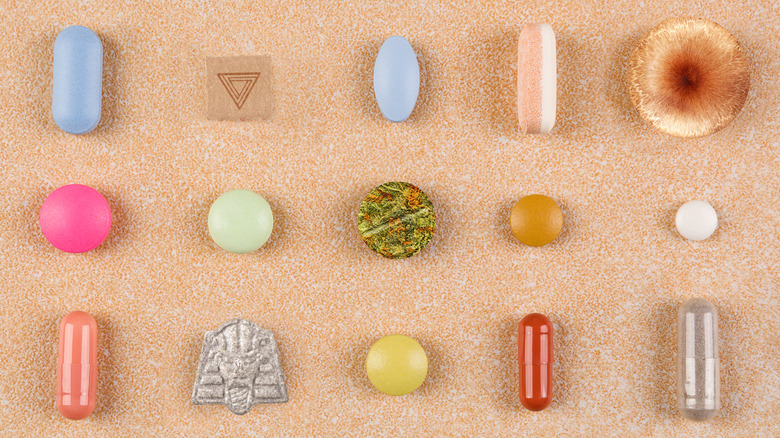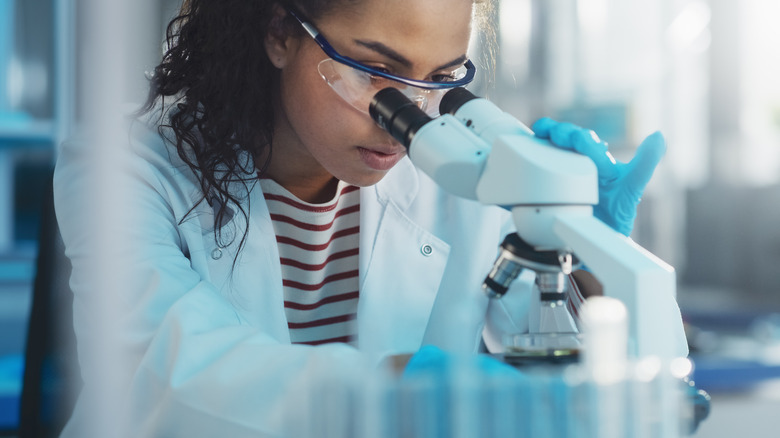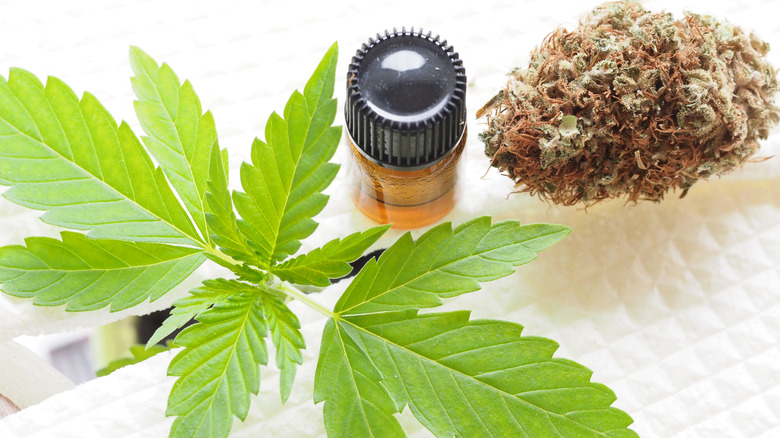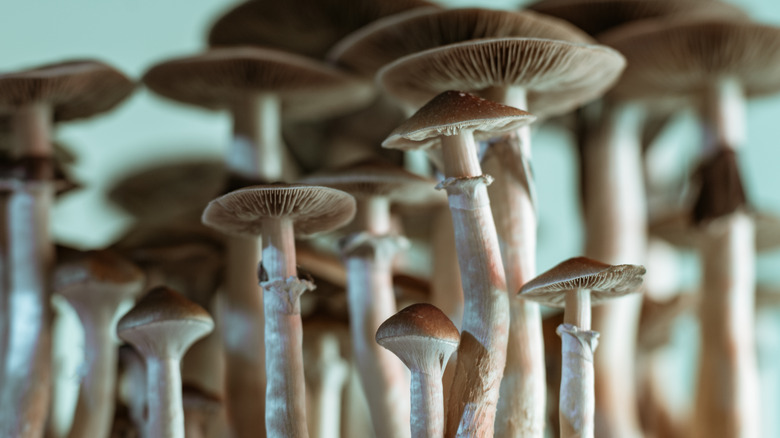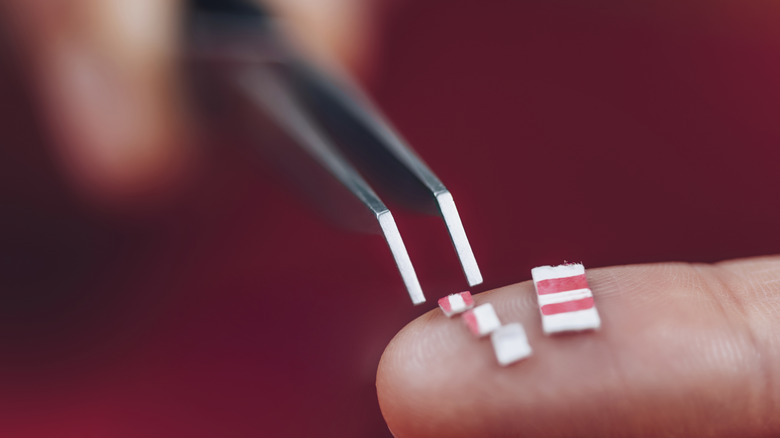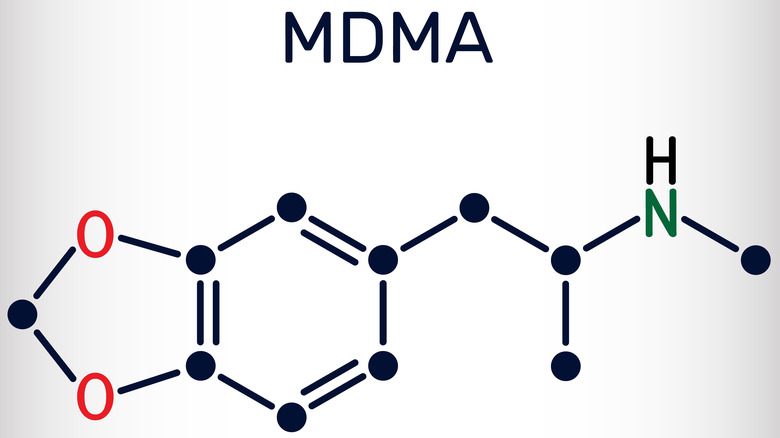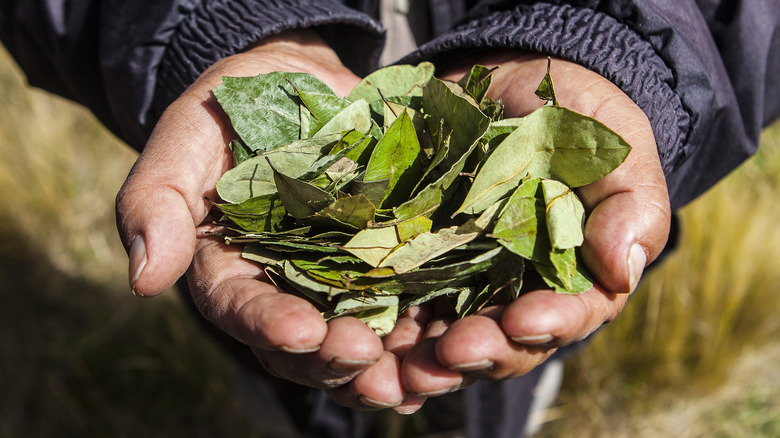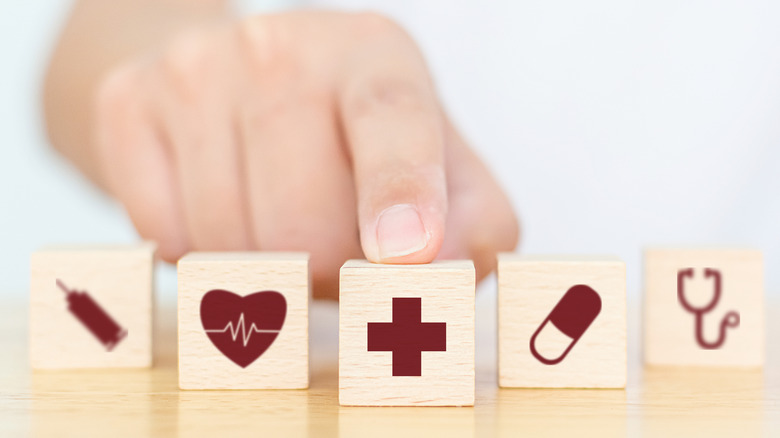Illicit Drugs That Have Medicinal Benefits
Per the definition of the Centers for Disease Control and Prevention, illicit drugs are "illegal or controlled" substances. Nowadays, there is an abundance of news and social media coverage, interest, and even misinformation on the potential medical benefits of illicit substances. Indeed, this topic is controversial, and for good reason.
Self-administering illegal or controlled drugs can be dangerous, sometimes even to the point of lethality. The possible dangers of self-medication practices include (but are not limited to) misdiagnosing one's own condition, refusing or delaying consultation with a medical professional, and even drug dependence, according to a paper in Current Drug Safety. Beyond that, long-term substance use can alter the brain's neurochemical reward system in ways that result in impaired judgment, memory, behavior, learning, and/or decision making (via the National Institute on Drug Abuse).
At the same time, however, a growing body of research supports a variety of possible health benefits related to therapeutic illicit drug use (per Live Science). An increasing number of states are sanctioning the use of medical marijuana and other substances every year. Over the years, studies have shed light on the possible medicinal benefits of such illicit substances, with potential positive outcomes that may be physical or psychological in nature (via CBS).
How illicit drugs are researched
In the United States, the Food and Drug Administration (FDA) is in charge of making sure that drugs are safe and effective. The FDA's Center for Drug Evaluation and Research (CDER), in particular, is responsible for prescription and over-the-counter (OTC) drug evaluation. When a company submits a new drug application for approval, a panel of experts including doctors, chemists, pharmacologists, statisticians, and scientists review proposals (via the FDA).
Approval by the Drug Enforcement Administration (DEA) is also required (via Discover Magazine). As LSD researcher Bryan Roth of UNC Chapel Hill Medical School explained, "Basically you apply to the DEA and then fill out much paperwork... It took in total around two years to finally get the license after much paperwork back and forth and a site visit by the DEA." The DEA may also randomly audit the research lab if you are studying illicit substances.
In Europe, organizations like the Psychedelic Access and Research European Alliance (PAREA) are advocating for public health-fueled research, education, and access to psychedelics in the European Union. PAREA is concerned that barriers to research may mean that therapeutic tools that could help will not reach those in need until research policies catch up. "It is likely that several drugs currently classified under Schedule I have important therapeutic potential[... but] the classification of drugs as Schedule I amounts to an insurmountable barrier to research," researchers wrote in the American Journal of Bioethics.
Marijuana
While the FDA has not approved cannabis as a medication, it has approved cannabis-derived Epidiolex (cannabidiol) and cannabis-related prescription drugs Cesamet (nabilone), Marinol (dronabinol), and Syndros (dronabinol). Meanwhile, the National Institute on Drug Abuse has funded a variety of cannabis and cannabinoid research, including research on THC vaping, the effects of THC on the brain, potential long-term effects, prenatal impacts, marijuana use disorder, and the potential therapeutic benefits for pain, addiction, and illness.
In particular, the NIDA reports that THC-based medications Cesamet and Marinol can treat chemotherapy nausea in cancer patients and stimulate appetite in AIDS-related wasting syndrome (via the National Institute on Drug Abuse). CBD-based Epidiolex has also been FDA approved to treat some forms of pediatric epilepsy, as well as Lennox-Gastaut syndrome and Dravet syndrome. A prescription mouth spray called Nabiximols (Sativex) has been approved in Canada, the United Kingdom, and other European Union countries for neuropathic pain related to multiple sclerosis.
While now legalized in 29 states, marijuana remains illegal on a federal level. The majority of Americans support the legalization of medical marijuana (via Harvard Medical School). Many people report chronic pain relief with recreational use. Other potential uses include weight loss, as well as the treatment of n tremors in Parkinson's disease tremors, endometriosis, fibromyalgia, glaucoma, irritable bowel syndrome, insomnia, and anxiety.
Ketamine
Globally, the third most prevalent disability is clinical depression (via the National Library of Medicine). While often treatable with antidepressant drug therapy, around a third of depressed individuals struggle with drug resistance. Ketamine has been researched for use in treating depression symptoms for decades, and was recently approved by the FDA for use in depression.
According to research from the National Institute of Health, chronic stress can lead to neurological changes and subsequent depression. In mice, ketamine was able to restore a level of normal prefrontal cortex brain activity and promote the growth of new neurons, effectively restoring the brain after chronic stress impaired its functioning. Behavior changes in these mice were observed within a few hours, and restored brain structure was seen within 12 to 24 hours.
In the United Kingdom, ketamine therapy for alcohol use disorder is also now in research trials (via BBC News). Other researchers are exploring the drug's potential use in anorexia, which has no current drug treatment (via Psychology Today United Kingdom). Other purported possible ketamine therapy benefits include alleviation of symptoms of post-traumatic stress disorder, anxiety, substance use disorders, obsessive-compulsive disorder, and bipolar disorder, according to Psychology Today.
If you or someone you know needs help with mental health, please contact the Crisis Text Line by texting HOME to 741741, call the National Alliance on Mental Illness helpline at 1-800-950-NAMI (6264), or visit the National Institute of Mental Health website.
Mushrooms
Psilocybin mushrooms, also known as "magic mushrooms," are psychedelics (hallucinogens) most often consumed recreationally in raw, dried, or tea form (via Psychology Today). Use may lead to experiences of calm, a sense of lightness, sedation, time and perception distortions, deep insights, anxiety, paranoia, or occasional flashbacks and hallucinations. Effects may last for several hours or more. Research on the potentiality for clinical use of psilocybin use in treatment-resistant depression has shown some promising results.
A Johns Hopkins Medicine study showed that psilocybin therapy treatment may relieve major depressive disorder symptoms for up to a year. However, study co-author Natalie Gukasyan, M.D., warned readers against trying it on their own, stressing that despite what their findings suggest, it's important to remember that their research was conducted with a significant amount of preparation and input from medical experts and professionals.
Psychedelic mushrooms have been increasingly studied for mental health disorders and substance use disorder treatment. More research is being developed. Johns Hopkins Center for Psychedelic and Consciousness Research reports that researchers there are "just beginning to understand its effects on the brain and mind and its potential as therapeutics for mental illnesses," and have been backed by $17 million in funding toward further study on psychedelics for health.
LSD
Lysergic acid diethylamide (LSD) or acid is a hallucinogenic drug first manufactured in 1938, according to Drugs.com. It's a lab-made, synthetic drug made from lysergic acid, which is found in a fungus that grows on grains like rye. LSD was popularized in the United States by cultural revolution icons of the 1960s, such as "One Flew Over the Cuckoo's Nest" author Ken Kesey, Tom Wolfe, who documented its use in the 1968 book "The Electric Kool-Aid Acid Test," and Harvard University psychology professors Timothy Leary and Richard Alpert, later known as Baba Ram Dass (via History).
An extensive research review of previous studies indicates that LSD may be especially indicated for use in alcohol addiction. Norwegian research shows that it may also prevent alcohol use disorder relapse (via Live Science). Scientists are calling for further, updated research on LSD's potential therapeutic uses. "LSD worked in an entirely different way than any current psychiatric drugs," said LSD researcher Teri Krebs of the Norwegian University of Science and Technology, stating that it has helped numerous patients understand and acknowledge both their alcohol dependence and the need to overcome it.
MDMA
MDMA, also commonly known as ecstasy, is a synthetic hallucinogen which can create sensations of euphoria and increased energy levels (via Live Science). Scientists have found it may be useful in addressing post-traumatic stress disorder. Additionally, new research shows it may have remarkable anti-cancer properties, particularly in the treatment of leukemia, lymphoma, and myeloma. "Further work is required, but this research is a significant step forward in developing a potential new cancer drug," stated researchers.
The National Institute on Drug Abuse warns, however, that repeated and long term ecstasy use can damage the neurochemical receptors in the brain, even several years later. According to Psychology Today, the drug can be dangerous or lethal, but therapeutic potential also exists in small doses. MDMA increases both dopamine and serotonin in the brain synapses, creating a sense of trust and love, but also creating a high risk for problem use. Further research is needed.
Cocaine
For centuries, the South American coca plant leaf was consumed for energy (via the Alcohol and Drug Foundation). Cocaine, often called blow or coke, is a stimulating illicit drug that is derived from the coca leaf. Cocaine has numbing or anesthetic properties, and can be used in minor surgical procedures (per the Mayo Clinic). Sigmund Freud was an early proponent of cocaine use and wrote about his experiences with it enthusiastically, but eventually became addicted and experienced negative impacts (via Narconon). The late 1800s saw cocaine's appearance in a number of over-the-counter products, including tooth drops and Coca Cola.
Cocaine has a high potential for addiction. According to the National Institute on Drug Abuse, its dopamine dump and subsequent high level of energy production don't last long, promoting frequent and repeated use. Additionally, cocaine use is lethal due to the presence of poisonous synthetic substances as additives. Besides, dependency, impaired judgment, overdose, heart issues, and stroke are medical risks that come with use. However, as a topical nasal analgesic spray, cocaine is still safely used medicinally in hospitals as a numbing agent.
If you or anyone you know needs help with addiction issues, help is available. Visit the Substance Abuse and Mental Health Services Administration website or contact SAMHSA's National Helpline at 1-800-662-HELP (4357).
Psychedelics for PTSD
In general, psychedelics that are typically illegal are becoming a hot area of research and debate. In June 2022, a New York Times article recounted the counter-culture psychedelic drug use of 1960s CIA and U.S. Army research of the Vietnam era, the political backlash against hallucinogens of the time, and how over 50 years later, Department of Veteran Affairs researchers are now exploring psychedelic use for veterans with post-traumatic stress disorder (PTSD). Researchers are hopeful that illicit substances like MDMa and Psilocybin, when administered in a safe, therapeutic environment, can help the brain rewire after the impacts of trauma.
"It's brand-new to a lot of people and yet it's been around longer than most of our psychiatric medications have been around," says Christopher Stauffer, M.D., of Portland, Oregon. "But it feels like we're approaching it this time with a lot more knowledge and a lot of more rigorous research practices that didn't really exist back in the '50s and '60s."
Indigenous cultures have traditionally used psychedelics for healing, and researchers are now coming to understand why — and that PTSD and related issues may improve through psychedelic therapy (via Psychology Today). With that said, drugs like psilocybin and MDMA are still illegal in the United States. Currently, though, over 200 clinical trials are federally registered to explore their use for conditions like PTSD (via Smithsonian Magazine).
Criticisms and concerns about the therapeutic use of illicit drugs
With illicit or illegal drugs, the risks that come with usage are often more serious. If you are interested in the possible therapeutic or medical benefits of what are traditionally considered street drugs, it's best to research and explore options with your medical provider. Research trials are becoming more and more common, and laws are changing from state to state as more information is gathered.
In discussions revolving around the medicinal benefits of illicit drugs, their risks should definitely be considered as well. For example, ketamine has been shown to have medical use, but street use of ketamine has a high risk of dependency (via Cambridge University). Consuming drugs like MDMA on the street always presents dangers, since street drugs are unregulated and can contain unknown ingredients (via Drug Policy Alliance).
Even seemingly low-risk substances do alter the mind and body and come with inherent concerns. Medical marijuana policy naysayers argue that the drug can lead to cognitive and memory decline, use disorder, or a lower quality of life in general (via DrugAbuse.com). And perhaps unsurprisingly, there are people who argue that the medical use of illicit drugs is just an excuse to legalize them.

